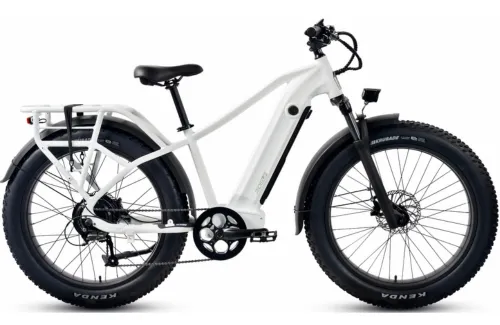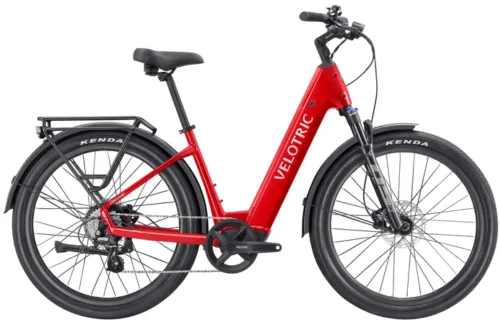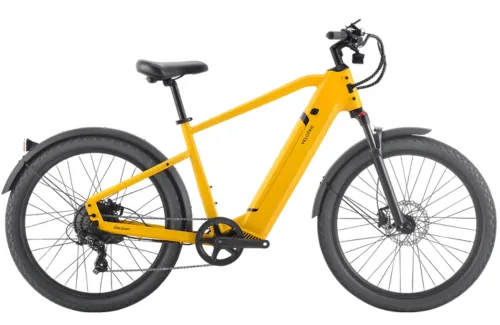Ride1Up has officially entered the world of off-road ebikes with the release of the Rift. In this Ride1Up Rift vs Cafe Cruiser comparison, we’ll highlight the differences between the popular commuter ebike and the recently released off-road ebike from the brand.
In comparison to Cafe Cruiser, the Ride1Up Rift offers a higher range and an improved front suspension fork. However, the Cafe Cruiser is much lighter at 65 lbs as compared to the Rift which weighs around 84.5 lbs.

Affiliate Disclosure: This blog post contains affiliate links. As an associate in the Amazon affiliate network (and others), we may earn commission from qualifying purchases at no additional cost to you!
Best Alternatives to Ride1Up Rift and Cafe Cruiser
ide1Up Rift and Cafe Cruiser are decent ebikes but lack UL certifications for battery and other electrical components. Consider the following ebike if you need a safer alternative.
1. Velotric Discover 2
Velotric Discover 2 is the most premium option in this category and price range.

Key Features:
- UL 2271 Recognized Battery
- Responsive Torque sensor
- Works with Apple Find My
- 48V, 706Wh Samsung Cells
- 750W (75Nm Torque) Hub Motor
- Hydraulic Disc Brakes
- 8-speed Shimano Drivetrain
- Tektro Hydraulic Suspension Fork
- 75 Miles of Max Range
- 28mph Top Speed
- 3A Fast Charging
- IPX6 Water Resistance
- 440 lbs of Weight Capacity
- Kenda 27.5″x2.4″ Puncture-resistant Tires
2. Velotric Discover 1
Velotric Discover 1 does not compromise on safety as it features the UL-2271 recognized battery which can be easily verified on UL’s official database.

Key Features:
- UL 2271 Recognized Battery
- 48V, 14.4Ah Samsung Cells
- 500W (900W Peak) Hub Motor
- Hydraulic Disc Brakes
- 7-speed Shimano Drivetrain
- Hydraulic Suspension Fork
- 65 Miles of Max Range
- 3A Fast Charging
- IPX6 Water Resistance
- 440 lbs of Weight Capacity
- 26″x2.5″ Puncture-resistant Tires
Recommended Accessories for Ride1Up Rift and Cafe Cruiser
Let’s start the Ride1Up Rift vs Cafe Cruiser comparison with the electrical specifications and key features.
Ride1Up Rift vs Cafe Cruiser: Electrical Specs & Key Features
| Electrical Specs & Key Features | Ride1Up Rift | Ride1Up Cafe Cruiser |
|---|---|---|
| Motor Power | Rear Hub Motor Nominal Power: 750W | Rear Hub Motor Nominal Power: 750W |
| Max Torque | 95nm | 60nm |
| Top Speed | 28 mph (PAS) 20 mph (Throttle) | 28 mph (PAS) 20 mph (Throttle) |
| Battery | 48V, 20 Ah (960Wh) Removable Battery | 48V, 15 Ah (720Wh) Removable Battery |
| Range | 45-60 miles | 30-50 miles |
| Sensors | Cadence Sensor | Cadence Sensor |
| Pedal Assist | 5 Levels | 5 Levels |
| Throttle Mode | Thumb Throttle | Thumb Throttle |
| Charging Time | 4-6 hours | 4-6 hours |
| Ebike Class | Class 2/3 | Class 2/3 |
| Headlight | Yes | Yes |
| Taillights | Yes | Yes |
Ride1Up Rift offers more Torque:
One of the subtle differences between these Ride1Up ebikes is that the Rift’s motor offers a maximum torque of 95nm compared to the 60nm torque you get with the Cafe Cruiser.
Both Ride1Up Cafe Cruiser and Rift feature a 750W rear hub motor. However, the higher torque in Rift ensures the bike performs better while riding on hills.
Although you’ll see a difference in acceleration of these ebikes, the speed limits are the same. On throttle mode, the speed is limited to 20mph on both of these bikes. And you can go up to 28mph in the pedal-assist mode.
Let’s compare the Ride1Up Rift vs Cafe Cruiser range next.
Rift’s throttle-only range is greater than Cafe Cruiser:
Since the Ride1Up Rift features a 20Ah (960 Wh) battery, it can offer a much better range than the Cafe Cruiser. In comparison, the Ride1Up Cafe Cruiser features only a 15 Ah (720Wh) battery.
In the throttle-only mode, Ride1Up Rift can power you up to 45 miles, 15 miles more than the Cafe Cruiser.
However, in the pedal-assist mode, the difference is not that significant as the Cafe Cruiser can offer you a maximum range of 50 miles, just 10 miles less than the Rift.
Of course, these estimates are based on some standards and there are a lot of variables involved. For instance, if you are a heavier rider, you may expect a lower range than these estimates.
Still, the important takeaway here is that the Ride1Up Rift’s throttle-only range is 1.5 times that of the Cafe Cruiser, and this must be considered before you make a decision.
Cadence Sensor in both Ride1Up Rift and Cafe Cruiser:
Both of these Ride1Up ebikes feature a cadence sensor which does a decent job if you can ignore a few milliseconds delay before the motor responds to your pedaling efforts.
Now, we do wish to have a torque sensor in every ebike we review. But we understand that Ride1Up wants to keep its ebike affordable as well. Currently, LMT’D and Prodigy are the only two electric bikes from the brand that feature a torque sensor.
Now, you know the electrical specs of these ebikes. Let’s look at the Ride1Up Rift vs Cafe Cruiser design differences.
Ride1Up Rift vs Cafe Cruiser: Design, Dimensions, & Weight Limits
| Dimensions, Design & Weight Limits | Ride1Up Rift | Ride1Up Cafe Cruiser |
|---|---|---|
| Frame | Step-Through Step Over (XR) | Step-Through Step Over (XR) |
| Color Options | Forest Green Arctic White Graphite Gray | Indigo, Matte Carbon, Matte Latte, Gloss |
| Bike Weight | 84.5 lbs | 65 lbs |
| Max Payload Capacity | 350 lbs | 350 lbs |
| Rear Rack Load Capacity | 150 lbs | 130 lbs |
| Rider Height | ST: 5’1″-6’2″ XR: 5’6″-6’4″ | ST: 5′-6’4″ XR: 5’5″-6’4″ |
| Stand Over Height | ST: 19″ XR: 29″ | ST: 23″ XR: 29″ |
| Min Seat Height | ST: 33″ XR: 34″ | ST: 31″ XR: 33″ |
| Max Seat Height | ST: 44″ XR: 44″ | ST: 38″ XR: 40″ |
Cafe Cruiser is Lighter:
One of the downsides of getting the all-new Ride1Up Rift is that the bike is really heavy at 84.5 lbs. In comparison, the Ride1Up Cafe Cruiser weighs just 65 lbs which is normal in this ebikes category.
Does that mean you shouldn’t get the Rift? Nope. Fat tire ebikes are generally heavier than cruiser ebikes as they need to handle some tough terrain.
Moreover, the Rift features a more powerful motor so you won’t feel the difference while riding the bike. However, if you ever need to lift the bike, you’ll definitely feel the extra weight of the Rift.
Rift has a low step-through design:
One of the surprising things about the Ride1Up Cafe Cruiser is that its step-through frame has a higher stand-over height compared to the Rift.
To be honest, the step-through frame of the Cafe Cruiser looks more like a low step-over frame. That’s why the stand-over height of the Cafe Cruiser ST frame is 23″, 4″ higher than the step-through frame of Rift.
In contrast, the Rift has a normal step-through frame which you see in every other ebike in the market. So, it’s a lot easier to get on the Rift step-through frame as compared to the Cafe Cruiser.
And if you have trouble raising your legs due to any health problem, then Rift’s step-through frame is more suitable for you.
Rift offers a higher rear rack load capacity:
We have already mentioned that the Rift has a heavier frame than the Cafe Cruiser. As the frame of Rift is much sturdier, it can bear a rear rack load of up to 150 lbs. This means you can easily carry an adult on the rear rack.
And Ride1Up offers the passenger kit just for that purpose. You’ll be surprised to know how easy it is to lock and unlock this passenger seat on the rear rack. Just make sure that you don’t exceed the overall maximum payload capacity of the ebike: 350 lbs.
Ride1Up is unique in the sense that its rear racks are always part of the actual frame and therefore can bear a lot of load. Regular ebikes come with a rear rack load capacity of 55 lbs.
As for the Cafe Cruiser, it has a rear rack load capacity of 130 lbs. So, you can use its passenger kit to carry children with you if necessary.
Let’s move onto the Ride1Up Rift vs Cafe Cruiser components comparison to see which ebike has an edge over the other.
Ride1Up Rift vs Cafe Cruiser: Other Components
| Other Components | Ride1Up Rift | Ride1Up Cafe Cruiser |
|---|---|---|
| Brakes | 4-piston Hydraulic Disc Brakes + Cut-Off Sensor | Hydraulic Disc Brakes + Cut-Off Sensor |
| Fork | Front Suspension 120mm Travel | Front Suspension 80mm Travel |
| Shifter | 8 Speed Shimano | 8 Speed Shimano |
| Tires | 26” x 4” Kenda Krusade | 26” x 3” Sandstorm |
| Rear Derailleur | Shimano Altus | Shimano Acera |
| Seatpost | Standard | Standard |
| Rear Rack | Included | Included |
| Rear Fenders | Included | Included |
Rift has Fat Tires:
Since Rift is a fat tire ebike, it comes with 26” x 4” Kenda Krusade tires which make your ride smooth on rough terrains. Kenda is a famous brand when it comes to durable tires and Ride1Up has done a great job by including their tires in their off-road ebike.
On the other hand, Cafe Cruiser has 26” x 3” Sandstorm tires which are pretty good for a commuter ebike. Most of the commuter ebikes come with 2.1″ or 2.5″ tires so you are getting some good wheels in the Cafe Cruiser as well.
You get 120mm front suspension in Rift:
To make your rides even smoother on rough terrain, Ride1Up has included a front suspension fork with 120mm of travel. The suspension is enough to handle most of the bumps you encounter on your rides.
In contrast, the Cafe Cruiser has a front suspension fork with 80mm of travel. Again, this is impressive considering Cafe Cruiser is a commuter ebike. Regular commuter ebikes on the market feature a 50-60mm travel fork.
Unfortunately, Rid1Up hasn’t included rear suspension in any of these ebikes which makes sense considering how affordable these rides are.
Rift offers more braking power:
It is a great luxury to have hydraulic brakes in these affordable ebikes from Ride1Up.
Although both Ride1Up Rift and Cafe Cruiser feature hydraulic disc brakes, the Rift has 4-piston brakes which offer a better braking experience.
This is a well-thought-out move from Ride1Up as the Rift is a heavy ebike and you need some solid brakes onboard to stop this off-road ebike.
And 4-piston hydraulic disc brakes with 180mm rotors do the job perfectly here. Both Rift and Cafe Cruiser also feature electric cut-off sensors to facilitate braking efforts.
Similar Components in Rift and Cafe Cruiser:
Apart from the differences discussed above, these bikes have similar components.
Starting with the transmission, both ebikes from Ride1Up feature Shimano 8-speed shifter. The Ride1Up Cafe Cruiser features Shimano Acera while the Rift comes with Shimano Altus rear derailleur.
Both Ride1Up Rift and Cafe Cruiser come with a sturdy rear rack and fenders without any additional payment as well.
Ride1Up Rift vs Cafe Cruiser: Price
| Ride1Up Rift | Ride1Up Cafe Cruiser | |
|---|---|---|
| Ebike Cost | $1895 | $1595 |
| Shipping Charges | Free Delivery | Free Delivery |
Ride1Up has priced the Rift fat tire ebike at $1895, $300 higher than the current price of Cafe Cruiser.
The ebikes are priced reasonably by Ride1Up considering the number of features these ebikes are loaded with.
However, there are some more powerful ebikes in the same price range and we have listed some of the best alternatives at the start of the Ride1Up Rift vs Cafe Cruiser comparison.
Let’s move on to the final part of our Ride1Up Rift vs Cafe Cruiser comparison where you can read our verdict.
Ride1Up Rift vs Cafe Cruiser: Our Verdict
For an extra $300, the Ride1Up Rift offers you a more powerful motor, better brakes, a lower step-through frame, a higher rear rack load capacity, a larger throttle-only range, and a front suspension with larger travel.
The only downside of the Ride1Up Rift is its weight which is considerably more than the Cafe Cruiser.
Ultimately, it comes down to your intended use. If you need an ebike to cruise within the city on paved roads, Cafe Cruiser is the perfect partner for you.
However, if you need to ride on rough terrain, Rift can offer a more comfortable riding experience.
Recommended Reads:







